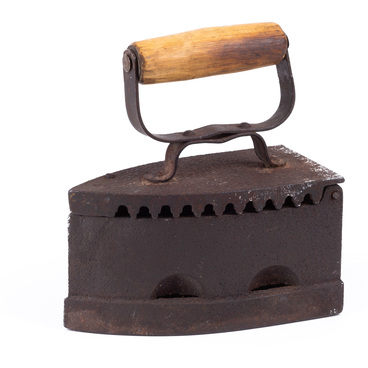The first sources of light in spaces fitted with amenities by people were a fire and a hearth. With the advent of torches and rushlights, it became possible to move the light between rooms, and even carry the light source outside. Therefore, rushlight holders became widespread: an implement to fix a burning rushlight. In Russia, people started to use rushlights as light sources by the 10th century. That was the approximate time when Russia first started to produce rushlight holders. In those days, they were usually made from old horseshoes, since metal products were still rare.
In terms of their ease of use, rushlights were much inferior to candles, which appeared in Russia by the 12th century. However, candles were considerably more expensive, and at the end of the 18th century a tax was imposed on them. At the same time, taxes were lifted from rushlights, which once again gave a boost to their common use in peoples’ everyday lives. That was when the rushlight holder was produced that is on display in the exposition of the Ethnography Hall. Right up to the 1940s, almost no house in Russian villages made do without rushlight holders, even though using rushlights for lighting was considered quite dangerous. The birch torchlight, which burned brightly and did not spread clouds of soot, was especially popular with peasants.
Rushlight holders were different in terms of shape and size. Three main forms are known: ones that hung suspended, those that stood on the floor, and those that stood on the table. One rushlight could not illuminate the entire hut, so due to this several rushlights were lit at once, and inserted into the holders at different places throughout the hut. The holders were placed so that the light evenly filled the entire room. Rushlight holders that consisted of a wooden trough with three or four legs were considered very convenient. The trough was fastened on a wooden post to a forged metal holder. The embers from the burning torchlight fell directly into the water that was poured into the trough.
Vessels with sand or water were often placed next to the rushlight holders — this way it was possible to quickly extinguish a smoldering rushlight. The designs of the rushlight holders that stood on the floor, which were completely forged from iron, had a lot of variation. A blacksmith could make any design fantasy come true. These rushlight holders were decorated with various types of spirals and flourishes. Using a forged pattern, the rushlight holders could take the form of a peacock’s tail, or even a feather of a mythical firebird.
In terms of their ease of use, rushlights were much inferior to candles, which appeared in Russia by the 12th century. However, candles were considerably more expensive, and at the end of the 18th century a tax was imposed on them. At the same time, taxes were lifted from rushlights, which once again gave a boost to their common use in peoples’ everyday lives. That was when the rushlight holder was produced that is on display in the exposition of the Ethnography Hall. Right up to the 1940s, almost no house in Russian villages made do without rushlight holders, even though using rushlights for lighting was considered quite dangerous. The birch torchlight, which burned brightly and did not spread clouds of soot, was especially popular with peasants.
Rushlight holders were different in terms of shape and size. Three main forms are known: ones that hung suspended, those that stood on the floor, and those that stood on the table. One rushlight could not illuminate the entire hut, so due to this several rushlights were lit at once, and inserted into the holders at different places throughout the hut. The holders were placed so that the light evenly filled the entire room. Rushlight holders that consisted of a wooden trough with three or four legs were considered very convenient. The trough was fastened on a wooden post to a forged metal holder. The embers from the burning torchlight fell directly into the water that was poured into the trough.
Vessels with sand or water were often placed next to the rushlight holders — this way it was possible to quickly extinguish a smoldering rushlight. The designs of the rushlight holders that stood on the floor, which were completely forged from iron, had a lot of variation. A blacksmith could make any design fantasy come true. These rushlight holders were decorated with various types of spirals and flourishes. Using a forged pattern, the rushlight holders could take the form of a peacock’s tail, or even a feather of a mythical firebird.



